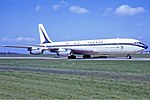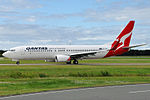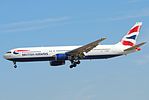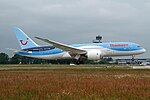| Revision as of 13:45, 1 November 2016 editFnlayson (talk | contribs)Extended confirmed users, New page reviewers, Pending changes reviewers, Rollbackers148,296 edits Partial revert, table is only for commercial aircraft, i.e. airliners. So no military aircraft listed.← Previous edit | Revision as of 13:49, 3 November 2016 edit undo171.7.134.182 (talk) Boeing Commercial AirplanesNext edit → | ||
| Line 9: | Line 9: | ||
| | predecessor = | | predecessor = | ||
| | successor = | | successor = | ||
| | foundation = {{Start date| |
| foundation = {{Start date|15 July 1916}} | ||
| | founder = ] | | founder = ] | ||
| | defunct = | | defunct = | ||
Revision as of 13:49, 3 November 2016
| This article needs additional citations for verification. Please help improve this article by adding citations to reliable sources. Unsourced material may be challenged and removed. Find sources: "Boeing Commercial Airplanes" – news · newspapers · books · scholar · JSTOR (March 2008) (Learn how and when to remove this message) |
| Company type | Private (division of The Boeing Company) |
|---|---|
| Industry | Aviation |
| Founded | 15 July 1916 (15 July 1916) |
| Founder | William Boeing |
| Headquarters | Renton, Washington, United States |
| Area served | Worldwide |
| Key people | Raymond Conner, President and CEO |
| Products | 737, 747, 767, 777, 787, Boeing Business Jet (BBJ) |
| Services | Maintenance, Training |
| Revenue | US$60 billion (FY 2014) |
| Number of employees | 83,347 |
| Parent | The Boeing Company |
| Website | boeing |
| Footnotes / references | |
Boeing Commercial Airplanes (BCA) designs, assembles, markets and sells jet airliners and business jets (Boeing Business Jets); it also provides product-related maintenance and training to customers worldwide. A business division of parent Boeing, Boeing Commercial Airplanes operates from division headquarters in Renton, Washington, with more than one dozen engineering, manufacturing, and assembly facilities located throughout the U.S. and internationally. Boeing Commercial Airplanes includes the assets of the Douglas Aircraft division of the former McDonnell Douglas Corporation, which merged with Boeing in 1997. The current President and CEO of Boeing Commercial Airplanes is Raymond Conner, the former head of Sales, Marketing and Services.
Products
Model naming convention
See also: List of Boeing customer codesFor all models sold beginning with the Boeing 707 in 1957, Boeing's naming system for commercial airliners has taken the form of 7X7. All model designations from 707 through 787 have been assigned, leaving 797 as the only 7X7 model name not assigned to a product.
For model numbers in the 707 to 777 range, the model number consists of an airplane's model number, for example 707 or 747, followed by a dash and three digits that represent the series within the model, for example 707-320 or 747-400. In aviation circles, a more specific model designation is sometimes used where the last two digits of the series designator are replaced by the two digit, alpha-numeric Boeing customer code, for example 747-121, representing a 747-100 originally ordered by Pan American World Airways (Boeing customer code 21) or 737-7H4, representing a 737-700 originally ordered by Southwest Airlines (Boeing customer code H4). Unlike other models, the 787 uses a single digit to designate the series, for example 787-8. This convention was followed in the development of the newest version of the 747, the 747-8. The 747 is the only model to use both the triple and single-digit designations (i.e., the 747-200, the 747-400, and the 747-8).
Additional letters are sometimes appended to the model name as a suffix, including "ER" to designate an "extended range" version, such as the 777-300ER, or "LR" to designate a "long range" version, for example 777-200LR. Other suffix designators include "F" for "freighter" (747-400F), "C" for "convertible" aircraft that can be converted between a passenger and freighter configuration (727-100C) and "M" for "combi" aircraft that are configured to carry both passengers and freight at the same time (757-200M, 747-400M). Passenger aircraft that are originally manufactured as passenger aircraft and later converted to freighter configuration by Boeing carry the suffix "BCF" designating a Boeing converted freighter (747-400BCF).
Aircraft in production or development
| Aircraft model | Number built | Description | Capacity | First flight | Variants in production | Out-of-production variants |
|---|---|---|---|---|---|---|
| 737 | 8,880 | Twin‑engine, single aisle, short- to medium-range narrow-body | 085-215 | April 9, 1967 | 700, 800, 900ER, BBJ, C-40, 737 AEW&C, P-8 | 100, 200, 200C, 200 Adv, 300, 400, 500, 600, 700ER, 900 |
| 747 | 1,520 | Heavy, four‑engine, partial double deck, twin aisle main deck, single aisle upper deck, medium- to long-range widebody | 467-605 | February 9, 1969 | 8I, 8F, BBJ | 100, 100SR, 100B, 200, 200F, 200C, SP, 200M, 300, 300M, 300SR, 400, 400M, 400D, 400F, 400ER, 400ERF, VC-25, E-4, YAL-1 |
| 767 | 1,083 | Heavy, twin-engine, twin aisle, medium- to long-range widebody | 180-375 | September 26, 1981 | 300F, KC-767, KC-46 | 200, 200ER, 300, 300ER, 400ER, E-767 |
| 777 | 1,367 | Heavy, twin-engine, twin aisle, medium- to long-range, ultra long-range (200LR), widebody | 301-550 | June 12, 1994 | 300ER, Freighter | 200, 200ER, 200LR, 300 |
| 787 | 370 | Heavy, twin-engine, twin aisle, long-range widebody | 210-330 | December 15, 2009 | 8, 9, 10, BBJ |
| Expected EIS |
Type | Description | Notes |
|---|---|---|---|
| 2017 | 737 MAX | A new 737 series based on 737NG with new engines | |
| 2020 | 777X | New 777 series, with the lengthened 777-9X, and extra long range 777-8X. It has a new engine, and new composite wings with folding wingtip | |
| Y1/737RS | Code name for the Boeing 737 and 757-200 replacement project | ||
| Y3 | Code name for the Boeing 747 and 777-300 replacement project |
Orders and deliveries
The table below lists only airliners from the jet era.
| Aircraft | Orders | Deliveries | Unfilled |
|---|---|---|---|
| 707 | |||
| 717 | |||
| 720 | |||
| 727 | |||
| 737 Original | |||
| 737 Classic | |||
| 737 NG | |||
| 737 MAX | |||
| 747 | |||
| 747-8 | |||
| 757 | |||
| 767 | |||
| 777 | |||
| 777X | |||
| 787 | |||
| Totals |
Data from Boeing through end of June 2016
Discontinued aircraft
| Aircraft model |
Number built |
Notes |
|---|---|---|
| 1 | 2 | |
| 6 | 1 | |
| 6D | 2 | |
| 7 | ||
| 8 | 1 | |
| 40 | 84 | |
| 64 | 1 | |
| 80 | 16 | |
| 81 | 2 | |
| 95 | 25 | |
| 200 Monomail | 1 | Converted into Model 221A as 8-passenger airliner |
| 203 | 7 | |
| 204 | 7 | |
| 221 Monomail | 1 | Converted into Model 221A as 8-passenger airliner |
| 247 | 75 | |
| 307 Stratoliner | 10 | |
| 314 Clipper | 12 | |
| 367-80 | 1 | |
| 377 Stratocruiser | 56 | Civil development of the military C-97 |
| 707 | 1,010 | |
| 720 | 154 | Modified variant of the 707 |
| 717 | 156 | Twin-engine narrow body jet, originally named MD-95 that evolved from the McDonnell Douglas DC-9 family |
| 727 | 1,832 | Three-engine narrow body jet |
| 757 | 1,050 | Narrow body twin-engine jet |
Gallery
- Boeing 7x7 series
-
 Boeing 707
Boeing 707
-
 Boeing 717
Boeing 717
-
 Boeing 727
Boeing 727
-
 Boeing 737
Boeing 737
-
 Boeing 747
Boeing 747
-
 Boeing 757
Boeing 757
-
 Boeing 767
Boeing 767
-
 Boeing 777
Boeing 777
-
 Boeing 787
Boeing 787
Specialty and other aircraft
Airlines commonly order aircraft with special features or options, but Boeing builds certain models specifically for a particular customer.
- The Boeing 707-138B was a shortened-fuselage, long-range model only sold to Qantas.
- The Boeing 757-200M was a single-example model built for Royal Nepal Airlines (now called Nepal Airlines). This plane could be converted between passenger and freighter configuration. It was launched by Royal Nepal Airlines in 1986 and delivered two years later.
- Boeing 747
- The Shuttle Carrier Aircraft
- The Boeing 747 Large Cargo Freighter is a wide-body cargo aircraft.
- The 747SP production resumed nearly four years after the supposedly final 747SP was built, to manufacture one aircraft for the United Arab Emirates. It had a cockpit crew of two instead of the three-crew layout of other 747SPs.
- Two Boeing VC-25s were built for the US Air Force as Presidential Air Force One transports. This model was a highly modified 747-200B.
- Boeing was a consultant to Sukhoi on the Russian Regional Jet program that subsequently became the Sukhoi Superjet 100 twin-engine narrowbody airliner.
Concepts
- Boeing 2707 – supersonic airliner, canceled.
- Boeing 7J7 – high-efficiency propfan airliner, canceled and may later resume for Y1.
- Boeing 747-300 Trijet - high-efficiency trijet version of the Boeing 747-200, canceled.
- Boeing New Large Airplane – double-deck jumbo airliner, canceled.
- Boeing RC-1 - cargo aircraft, canceled.
- Boeing Sonic Cruiser – near-sonic airliner, canceled.
- Boeing Liquid Hydrogen (LH2) Airplane
Airfoils
- Boeing 103 - used on Model 40 and F2B
- Boeing 103A - used on F2B and F3B
- Boeing 106 - used on Model 80, P-12, Monomail, Model 226
- Boeing 106B - used on Model 95, Model 247D, P-12
- Boeing 106R - used on various Beriev models
- Boeing 109 - used on Model 95 and P-26
- Boeing 117 - used on XPBB, B-29 and derivatives (307, 367, 377), all Aero Spacelines models, Tupolev Tu-4, Tu-70, Tu-75, Tu-80.
Organization
Boeing Commercial Airplanes (BCA) is organized as:
- Airplane Programs
- Renton - 737, BBJ, P-8A Poseidon
- Everett - 747, 767, 777, 787
- Fabrication Division
- Global Partners
- Propulsion Systems
- 787 Program
- Commercial Aviation Services
BCA subsidiaries:
- Aeroinfo Systems
- Aviall
- Aviation Partners Boeing, a 50/50 joint venture with Aviation Partners Inc.
- Boeing Canada
- Boeing Training & Flight Services (was Alteon Training)
- CDG
- Jeppesen, formerly Jeppesen Sanderson.
- Preston Aviation Solutions
- Global Aeronautica, formerly a 50/50 joint-venture with Alenia Aeronautica
Major facilities
- Long Beach, California - McDonnell Douglas aircraft assembly and testing. It currently supports Boeing Commercial Airplanes
- Seattle - Puget Sound region, Washington
- Boeing Field, Seattle, Washington - Flight testing for Boeing aircraft, except McDonnell Douglas-designed aircraft
- Boeing Everett Factory, Everett, Washington - 747, 767, 777, and 787 production and final assembly plant
- Boeing Renton Factory, Renton, Washington - 737 and former 707, 727 and 757 production and final assembly plant
- Boeing Charleston Factory, North Charleston, South Carolina - 787 subassemblies and final assembly plant
See also
- Airbus
- Bombardier Aerospace
- Comac
- Competition between Airbus and Boeing
- Embraer
- List of civil aircraft
- United Aircraft Corporation
References
- "2014 Annual Report" (PDF). The Boeing Company. February 26, 2015.
- ^ "Backgrounder" (PDF). The Boeing Company. November 2014.
Boeing Commercial Airplanes employs more than 83,000 people under the leadership of President and CEO Ray Conner. The business unit's revenue in 2013 was a record $53 billion.
- "Boeing Commercial Airplanes: A Better Way To Fly". The Boeing Company.
- "McDonnell Douglas shareholders approve merger with Boeing" (Press release). The Boeing Company. July 25, 1997. Archived from the original on January 19, 2011. Retrieved January 19, 2011.
McDonnell Douglas Corporation's (NYSE: MD) shareholders voted today to approve the merger with The Boeing Company (NYSE: BA).
- as of January 2016
- "The Boeing 737 Technical Site". B737.org.uk. Retrieved March 31, 2013.
- The Boeing 767 family. Boeing.
- Boeing 777 Family. Boeing Commercial Airplanes
- 787-8 Fact Sheet, 787-9 Fact Sheet. Boeing.
- Trimble, Stephen. "Boeing shows off completed horizontal stabiliser for 787-9". Flight International, January 15, 2013.
- "Boeing Business Jets". Boeing. Retrieved November 7, 2013.
- http://active.boeing.com/commercial/orders/index.cfm?content=displaystandardreport.cfm&pageid=m25066&RequestTimeout=20000
- Gervais, Edward L. (November 29, 2007). "Boeing Current and Future Product Review". Presentation to Federal Aviation Administration Great Lakes Region 23rd Annual Airport Conference. Boeing Commercial Airplanes. p. 54. Archived from the original (PDF) on March 18, 2008. Retrieved March 18, 2008.
- Aeroinfo Systems
- Aviall, Inc.
- Aviation Partners Boeing
- Boeing Training & Flight Services
- CDG
- Preston Aviation Solutions
- "Boeing Acquires Alenia North America's Interest in Global Aeronautica". Boeing, December 22, 2009.
External links
- Boeing Commercial Airplanes page
- BCA Recent orders summary page and BCA Orders and Deliveries report page
- Official site for Boeing's new airplanes
- Complete production list starting with Model 1
- Boeing’s Triumph: The American Jetliner
- BBC Q&A: Boeing and Airbus
| Boeing airliners and civil aircraft | |||||||||||
|---|---|---|---|---|---|---|---|---|---|---|---|
| Airliners |
| ||||||||||
| Civil trainers/ utility aircraft | |||||||||||
| Boeing 7x7 aircraft production timeline, 1955–present | ||||||||||||||||||||||||||||||||||||||||||||||||||||||||||||||||||||||||||||||||||||||||||||||||||||||||||||||||||||||||||||||||||||||||||||||||||||||||||||||||||||||||||||||||||||||||||||||||||||||||||||||||||||||||||||||||||||||||||||||||||||||||||||||||||||||||||||||||||||||||||||||||||||||||||||||||||||||||||||||||||||||||||||||||||||||||||||||||||||||||||||||||||||||||||||||||||||||||||||||||||||||||||||||||||||||||||||||||||||||||||||||||||||||||||||||||||||||||||||||||||||||||||||||||||||||||||||||||||||||||||||||||||||||||||||||||||||||||||||||||||||||||||||||||||||||||||||||||||||||||||||||||||||||||||||||||||||||||||||||||||||||||||||||||||||||||||||||||||||||||||||||||||||||||||||||||||||||||
|---|---|---|---|---|---|---|---|---|---|---|---|---|---|---|---|---|---|---|---|---|---|---|---|---|---|---|---|---|---|---|---|---|---|---|---|---|---|---|---|---|---|---|---|---|---|---|---|---|---|---|---|---|---|---|---|---|---|---|---|---|---|---|---|---|---|---|---|---|---|---|---|---|---|---|---|---|---|---|---|---|---|---|---|---|---|---|---|---|---|---|---|---|---|---|---|---|---|---|---|---|---|---|---|---|---|---|---|---|---|---|---|---|---|---|---|---|---|---|---|---|---|---|---|---|---|---|---|---|---|---|---|---|---|---|---|---|---|---|---|---|---|---|---|---|---|---|---|---|---|---|---|---|---|---|---|---|---|---|---|---|---|---|---|---|---|---|---|---|---|---|---|---|---|---|---|---|---|---|---|---|---|---|---|---|---|---|---|---|---|---|---|---|---|---|---|---|---|---|---|---|---|---|---|---|---|---|---|---|---|---|---|---|---|---|---|---|---|---|---|---|---|---|---|---|---|---|---|---|---|---|---|---|---|---|---|---|---|---|---|---|---|---|---|---|---|---|---|---|---|---|---|---|---|---|---|---|---|---|---|---|---|---|---|---|---|---|---|---|---|---|---|---|---|---|---|---|---|---|---|---|---|---|---|---|---|---|---|---|---|---|---|---|---|---|---|---|---|---|---|---|---|---|---|---|---|---|---|---|---|---|---|---|---|---|---|---|---|---|---|---|---|---|---|---|---|---|---|---|---|---|---|---|---|---|---|---|---|---|---|---|---|---|---|---|---|---|---|---|---|---|---|---|---|---|---|---|---|---|---|---|---|---|---|---|---|---|---|---|---|---|---|---|---|---|---|---|---|---|---|---|---|---|---|---|---|---|---|---|---|---|---|---|---|---|---|---|---|---|---|---|---|---|---|---|---|---|---|---|---|---|---|---|---|---|---|---|---|---|---|---|---|---|---|---|---|---|---|---|---|---|---|---|---|---|---|---|---|---|---|---|---|---|---|---|---|---|---|---|---|---|---|---|---|---|---|---|---|---|---|---|---|---|---|---|---|---|---|---|---|---|---|---|---|---|---|---|---|---|---|---|---|---|---|---|---|---|---|---|---|---|---|---|---|---|---|---|---|---|---|---|---|---|---|---|---|---|---|---|---|---|---|---|---|---|---|---|---|---|---|---|---|---|---|---|---|---|---|---|---|---|---|---|---|---|---|---|---|---|---|---|---|---|---|---|---|---|---|---|---|---|---|---|---|---|---|---|---|---|---|---|---|---|---|---|---|---|---|---|---|---|---|---|---|---|---|---|---|---|---|---|---|---|---|---|---|---|---|---|---|---|---|---|---|---|---|---|---|---|---|---|---|---|---|---|---|---|---|---|---|---|---|---|---|---|---|---|---|---|---|---|---|---|---|---|---|---|---|---|---|---|---|---|---|---|---|---|---|---|---|---|---|---|---|---|---|---|---|---|---|---|---|---|---|---|---|---|---|---|---|---|---|---|---|---|---|---|---|---|---|---|---|---|---|---|---|---|---|---|---|---|---|---|---|---|---|---|---|---|---|---|---|---|---|---|---|---|---|---|---|---|---|---|---|---|---|---|---|---|---|---|---|---|
| ||||||||||||||||||||||||||||||||||||||||||||||||||||||||||||||||||||||||||||||||||||||||||||||||||||||||||||||||||||||||||||||||||||||||||||||||||||||||||||||||||||||||||||||||||||||||||||||||||||||||||||||||||||||||||||||||||||||||||||||||||||||||||||||||||||||||||||||||||||||||||||||||||||||||||||||||||||||||||||||||||||||||||||||||||||||||||||||||||||||||||||||||||||||||||||||||||||||||||||||||||||||||||||||||||||||||||||||||||||||||||||||||||||||||||||||||||||||||||||||||||||||||||||||||||||||||||||||||||||||||||||||||||||||||||||||||||||||||||||||||||||||||||||||||||||||||||||||||||||||||||||||||||||||||||||||||||||||||||||||||||||||||||||||||||||||||||||||||||||||||||||||||||||||||||||||||||||||||
| Narrow body Wide body Overlapping production times like between the 747-400 and the 747-8 have been decided in favor of newer models | ||||||||||||||||||||||||||||||||||||||||||||||||||||||||||||||||||||||||||||||||||||||||||||||||||||||||||||||||||||||||||||||||||||||||||||||||||||||||||||||||||||||||||||||||||||||||||||||||||||||||||||||||||||||||||||||||||||||||||||||||||||||||||||||||||||||||||||||||||||||||||||||||||||||||||||||||||||||||||||||||||||||||||||||||||||||||||||||||||||||||||||||||||||||||||||||||||||||||||||||||||||||||||||||||||||||||||||||||||||||||||||||||||||||||||||||||||||||||||||||||||||||||||||||||||||||||||||||||||||||||||||||||||||||||||||||||||||||||||||||||||||||||||||||||||||||||||||||||||||||||||||||||||||||||||||||||||||||||||||||||||||||||||||||||||||||||||||||||||||||||||||||||||||||||||||||||||||||||
